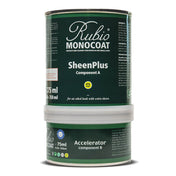VOC is the abbreviation for “Volatile Organic Compounds."
Volatile Organic Compounds is a generic term for chemical substances that evaporate into the air. Organic refers to the chemical composition of the components, and volatile refers to the fact that they evaporate.
VOCs are found in many products we use to build and maintain our homes and other structures. They are found in coatings, paint strippers, furnishings in buildings, cleaning products, disinfectants, cosmetics, degreasers, hobby products, etc.
There are different VOC free wood finishes, like Rubio Monocoat's Oil Plus 2C, but they are not the current majority.
Why do VOCs matter?
Health Concerns
Products that contain VOCs (for example, solvents used in industrial coatings or wood finishes) release vapors that may be hazardous to humans and the environment. Excessive and long-term contact with VOCs may cause allergic reactions, breathing problems, and eye problems. Notably, individuals with chemical sensitivities may become severely affected by exposure to even minimal quantities of VOCs.
Long-term and frequent exposure to VOC’s is known to cause adverse health effects in individuals like painting contractors, hardwood floor finishers, and other industrial tradespeople that are exposed to VOCs. A psycho-neurological disease that may develop in humans due to solvent exposure in occupational situations is known as “Organic Psychosyndrome." This syndrome is also referred to as “Painters Disease" or "Organic Solvent Syndrome." In the 1970s and 1980s, a lot of research was conducted studying the ill effects of exposure to VOCs.
Environmental Concerns
VOCs also affect the ozone layer and increase the greenhouse effect. As stated by the EPA, “VOCs are of interest in part because they participate in atmospheric photochemical reactions that contribute to ozone formation. Ozone is formed from chemical reactions involving airborne VOCs, airborne nitrogen oxides, and sunlight.”
Regulations on VOCs
Legislative bodies across the world have found it necessary to intervene and impose standards to reduce and control VOC emissions and reduce the exposure to the ill effects of VOCs. These regulations vary by location and are periodically updated as new information is discovered. Legislation is aimed at protecting both those who work with the products during manufacturing and application as well as people who will be living with and using the end products. Legislation is also in place to protect the environment.
Before getting into more detail, lets first look at Rubio Monocoat as a whole and explore why the lack of VOCs is such an important factor for our hardwax oil product line.
Industry norms
Despite the hazardous characteristics demonstrated in VOCs, most coating manufacturers are simply reducing the quantity of VOCs in their products. They reduce their VOC content to the lowest possible quantity, but they often do not abandon VOCs completely. This is because VOCs are used to help contribute to the optimal workability of traditional wood-finishing products.
Rubio Monocoat: 0% VOC!
Three years before the first VOC legislation came into effect, the Rubio Monocoat hardwax oil system was in the development phase at the Rubio Monocoat lab in Belgium. The bar was set significantly high by Rubio Monocoat in the area of emission reduction. Not just a low VOC content product, but a clear statement made by having a hardwax oil with 0% VOC. From the very start, Rubio Monocoat had already set emission norms that were stricter than those dictated in the European 2010 legislation.
With the bar set high (or at 0%), Rubio Monocoat products were developed using molecular bonding: a revolutionary technology in which the hazardous factors are eliminated while guaranteeing incontestable quality. Therefore, Rubio Monocoat can offer an oil-based wood finishing product without VOCs!
Rubio Monocoat wood finishes are a leading choice among those with chemical sensitivities and/or allergies. If you need additional information surrounding a sensitivity, please contact us.
Rubio Monocoat maintains this principle with the development of new hardwax oil products and improvements to our existing hardwax oil products.
Recommended 0% VOC interior wood finish: Oil Plus 2C
Recommended 0% VOC exterior wood finish: Hybrid Wood Protector


